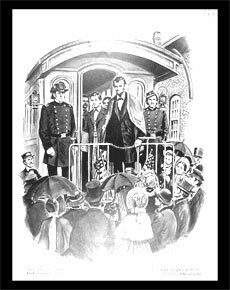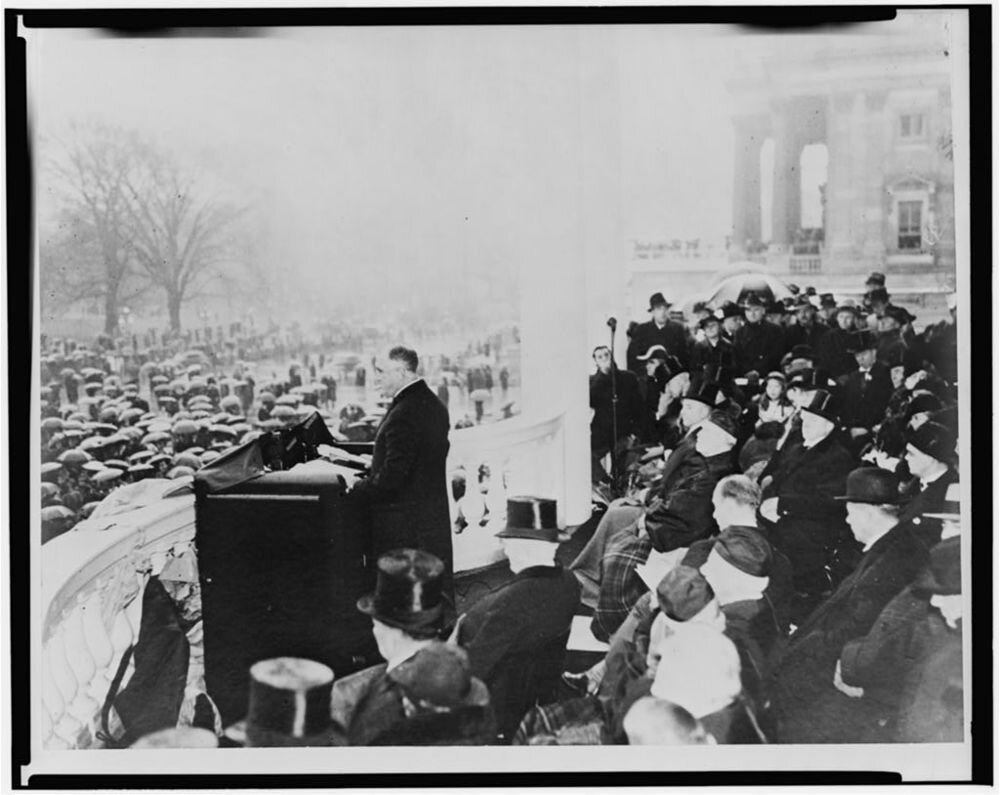Spot of Parchment, November 2020: The History of the Lame Duck Period
On Saturday, November 7, 2020, every major news outlet called the election for President-Elect Joe Biden. Yet, he will not take office until January 20, 2021. In any given transition year, that roughly 80 days between an election and an inauguration doesn’t seem that long, as new presidents have policies to announce, intelligence to learn, and 4,000 appointees to name. No that isn’t a typo. Most of these nominations aren’t made until after the inauguration, but that’s how many positions new presidents have to fill.
But this year, some people have asked why we have such a long lame-duck period, as President Trump is refusing to concede, firing senior staff at the Defense Department and Department of Homeland Security, and preventing President-Elect Biden from receiving intelligence briefings and messages from foreign leaders. (I wrote a piece for CNN about other things to watch for during the transition, you can read it here.) So I thought it might be helpful to explain the history of the transition period and why we still have it.
From the very beginning, the Constitution had a lot of wiggle room built into the process. Until 1845, each state determined their election day, so there was a range of local elections from April to early December. The states would then send their results to Congress to be certified. Without the internet, the telegraph, or even super reliable mail service, this process could take weeks to get results from all corners of the country. For example, in the election of 1800, Congress didn’t open the returns from states until February 11, 1801. Jefferson took the oath of office on March 4.
The U.S. Capitol Building in 1800, William Birch
Congress was even weirder. The Constitution initially required Congress to convene by December of each year. As a result, the lame-duck Congress from the previous term often held a special session to certify the president's election and attend the inauguration. Then they’d return home and the new session of Congress would start the following fall. As a result, for the first seven months of a new administration, the president often had no Congress with which he could work.
Why did the Constitution set up the system this way? Keep in mind, no one wanted to be in D.C. (or in cities in general) during the summer. They were hot, prone to outbreaks of disease, and had less recreational space. Additionally, many congressmen owned farms or plantations, and the summer and early fall were important seasons for overseeing crop cultivation and harvest.
The delay between the election and the opening of the new session of Congress also made sense from a technological standpoint. It took a while for news from the election to reach all of the newly-elected congressmen. Once they learned of their election, they had to prepare to leave their homes, farms/plantations, or businesses for several months. They had to hire overseers, pay laborers, make provisions to sell their goods, and hand off legal cases to colleagues—just to give a few examples.
They then had to travel to D.C., which was no easy feat. In April 1789, George Washington took several days to travel from Mount Vernon to New York for the first inauguration—and the roads, ferry crossings, and lodging opportunities from northern Virginia to New York City were some of the best in the nation at the time. Even as roads and transportation improved to include steam-powered ships and railroads, congressmen from the South and western regions still took several days or weeks to get to the capital.
After Congress passed legislation in 1845 creating a national election day, presidents usually received word of their election in the days or weeks following the election, depending on the closeness of the vote totals. Like congressmen, presidents prepared to leave their businesses for the next four years and their homes for at least several months. They also had to travel to D.C. to take office. For example, in 1861, Abraham Lincoln left Springfield, Illinois on February 11 and arrived in Washington, D.C. on February 23. He could have made the trip quicker, but used the opportunity to stop at towns along the way and visit with citizens, local dignitaries, and government officials.
Lincoln’s Whistle-stop Tour
Lincoln’s election in 1860, however, prompted the first round of conversations about moving up the date of the inauguration. Between Lincoln’s victory on November 6, 1800, and his inauguration on March 4, seven southern states seceded from the Union and formed the Confederacy. Because President James Buchanan was unable or unwilling to act to prevent the disintegration of the nation, many observers suggested that it will be helpful to get Lincoln into office faster. But the Civil War pushed those constitutional reforms to the back of the line.
The Great Depression again emphasized the dangers of a long lame-duck period. In October 1929, the stock market crashed, leading to years of increasing unemployment, inflation, declining farm prices, and hunger. President Herbert Hoover believed the market and private industry would correct the problem, especially if aided by austerity measures, like tax cuts for corporations and the wealthy. Outrage over his inaction led to Franklin D. Roosevelt’s overwhelming victory in 1932. And yet, the country had to sit around and wait for FDR to take office for several months before he could start to implement new programs to alleviate the suffering.
Congress could see this problem coming before the election occurred. Accordingly, on March 2, 1932, Congress passed legislation moving the inauguration from March 4 to January 20. The states quickly approved the new amendment, on January 23, 1933, Missouri became the 36th state to ratify (reaching the necessary ¾ mark for all new amendments to the Constitution). President Franklin D. Roosevelt’s second inauguration on January 20, 1937 was the first under this new schedule.
FDR’s Second Inauguration, 1937
You might be thinking, that’s well and good, but today we have the internet and airplanes. Surely that travel and those organizational details could be handled faster. And that’s certainly true. But the way the executive branch is structured requires a certain period of overlap. While most civil servants are not political appointees, there are still a lot that have to be replaced with every newly-elected president. They have to be vetted by the campaigns, vetted by the FBI, receive security clearance as necessary, before finally getting to work.
In 1963, Congress passed the Presidential Transition Act to help facilitate this increasingly-complex process. The act requires agencies to designate a senior career official to plan for a transition within the department. Incumbent presidents are required by law to create a transition coordinating council. The Act also requires the GSA to provide office space, administrative support to help the president and vice president-elect, funding to facilitate the transition, and oversee the process that now starts before the election.
This year has demonstrated that there is still room for improvement. Perhaps the GSA coordinator needs to have less discretion about deciding when to begin the official transition process or it should be more clearly articulated in the statute, so individuals cannot be put in uncomfortable positions. If you’d like to learn more about the Presidential Transition Act and recent transitions, I highly recommend the podcast Transition Lab from the Center for Presidential Transition.


